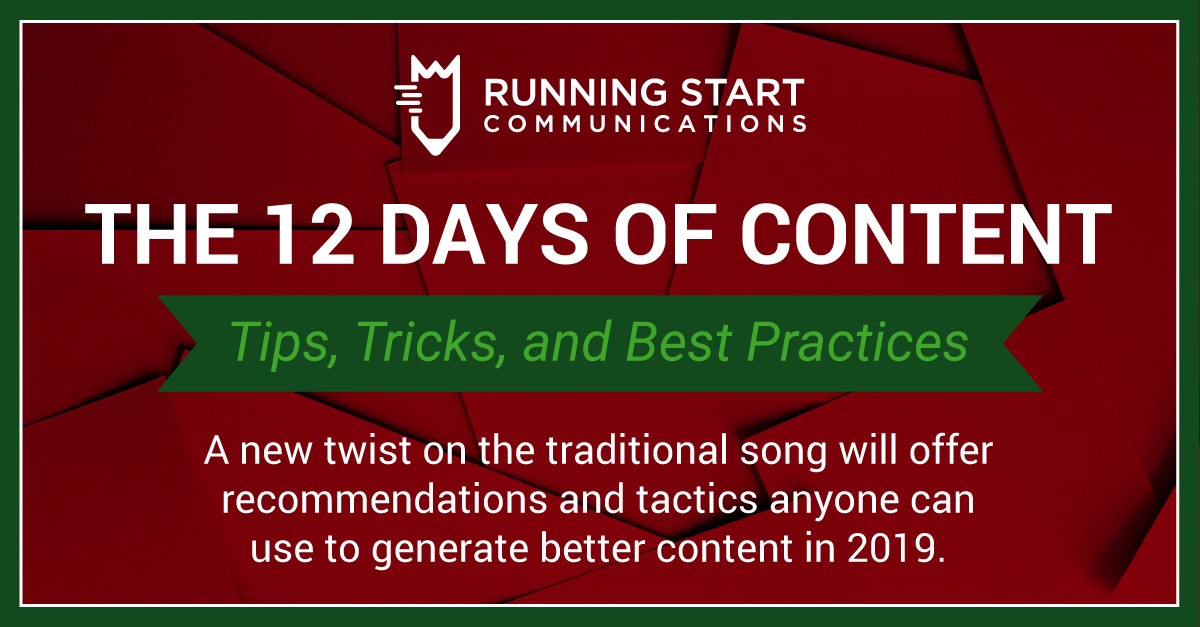
On the fifth day of “Content,” a random writer gave to me …
Five thoughts for writing a better blog post (or just about any piece of content).
1. Invest more time. Possibly much more time.
One of the biggest mistakes we see is rushing blog content.
Consider this: Why is it that we give writers many days to write a 750-word datasheet or case study, yet we sometimes expect them to write a blog in a few hours?
Sure, collateral may be printed, which may make it seem more important, but I think blogs should get equal treatment. Especially since Google is encouraging/rewarding longer articles today.
Some may also view blogs as temporary pieces of content – here for a moment, but quickly replaced in a digital feed. But with SEO and back-linking, they are more permanent than you may think, probably even more so than collateral.
Sure, it’s a lot of pressure to produce blogs each week/month, but do all you can to get ahead of your editorial calendar and give yourself/your writer more time to create better blogs.
2. Be creative! Come up with an interesting twist and headline.
You have to do all you can to differentiate your content, and nowhere is this more apparent than blog writing.
Now that you’ve all agreed follow the first tip and invest more time creating blogs, you need to use some of this time to be more creative. Come up with a concept or idea that supports your message, but in a way readers may not expect.
Not that we always get it right, but here’s one example:
Running Start once wrote a blog called “What the Clash Can Teach Us About Grammar,” which saw a spike in views and positive feedback. I’m sure we wouldn’t have seen those same numbers if we wrote a blog called “We Should All Know the Difference Between ‘Who’ and ‘Whom‘”!
It might be difficult, but push yourself to be creatively different. Readers will dive in, and over the long run, it will make your company stand apart.
3. Be careful with list-based tips articles.
First, I need to pause and acknowledge the irony here. I’m about to possibly discourage the use of tips list articles – in my own tips list article.
Let me explain … We all know that articles that offer “X Number of Ways to ______ ” (insert your benefit of choice here) have outperformed those that use more general headlines.
But the pendulum has swung too far, and in many cases, has made us lazy. So many teams try to capitalize on this trend by throwing together lists that are poorly conceived, watered down, and ultimately, disappointing to readers.
So if you’re going to use this approach, use it sparingly and make sure you have something to say. You may trick readers once or twice, but over time, they’ll tune you out.
4. No more content just for content’s sake.
Speaking of making sure you have something to say … make sure you have something to say.
Virtually every company on the planet is under pressure to generate more leads, drive more traffic, and produce better SEO results.
Also, virtually every company on the planet is trying to use content to help them achieve these goals.
It all adds up to too much content, much of which should never be published in the first place, including thinly disguised sales materials, warmed-over product information, or a third/fourth/fifth take on a topic that doesn’t add anything new.
“We need to publish something this week” is not a viable content marketing strategy. Respect your audience’s time and only publish when you have great content.
5. Don’t stop when the writing is done.
Many of us write content in Word and then turn it over to a digital marketing for uploading and publishing.
In doing so, we may miss an opportunity to make the piece even better.
For example, a writer should look at staged content before it is published. This is important to look for typos, online layout issues, links, and other issues related to how the content looks.
They should also write headlines, subheads, introductions and summaries that actually work for the company’s blog. WordPress and other platforms may pull content to create the intro, but then add […] in an awkward place. Or it may combine the headline with this first sentence, which will only confuse readers and make your company look less than professional.
Finally, writers should play a role in writing SEO elements, such as alternate tags, H1 and H2 headlines, title tags, and meta descriptions. Often this is overlooked, which reduces the overall SEO impact and defeats the entire purpose.
Happy Fifth Day of Content!
There you have it. Five thoughts to improve your approach to blog writing.
I hope this information is helpful, and that it’s on target with what you were looking for to improve your content and writing. But if you have any feedback or suggestions to make it better, I’m all ears.
I’d like to officially thank everyone for the feedback and encouragement I’ve received so far. A few good tips for upcoming blogs, too.
Have a great weekend and I’ll be in touch on Monday with my next article.

Leave A Comment